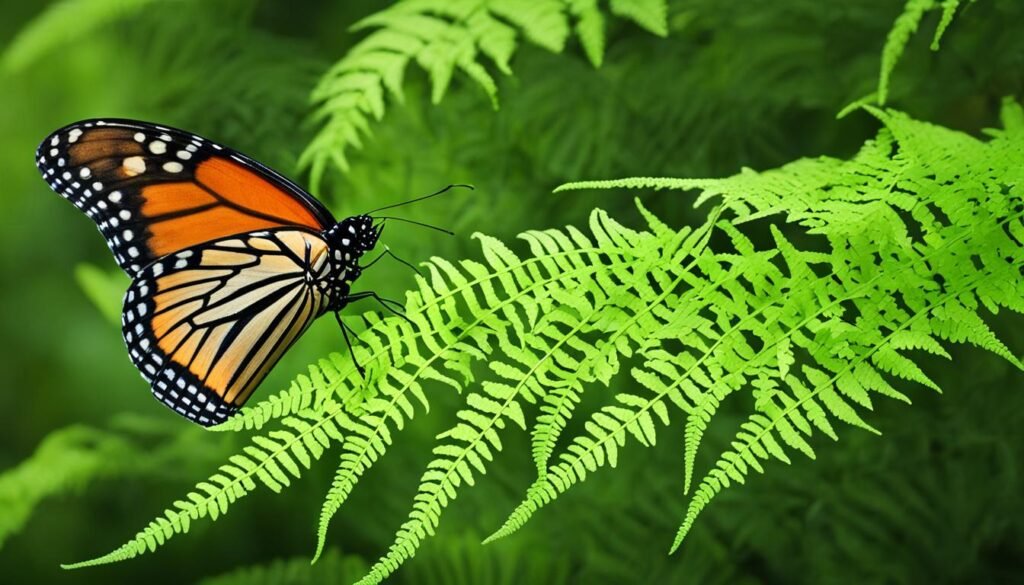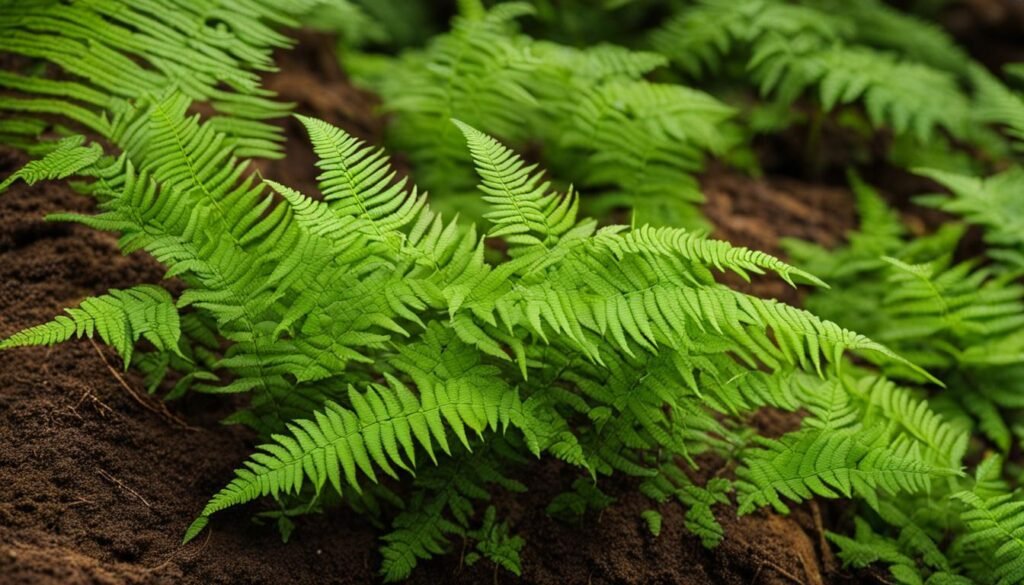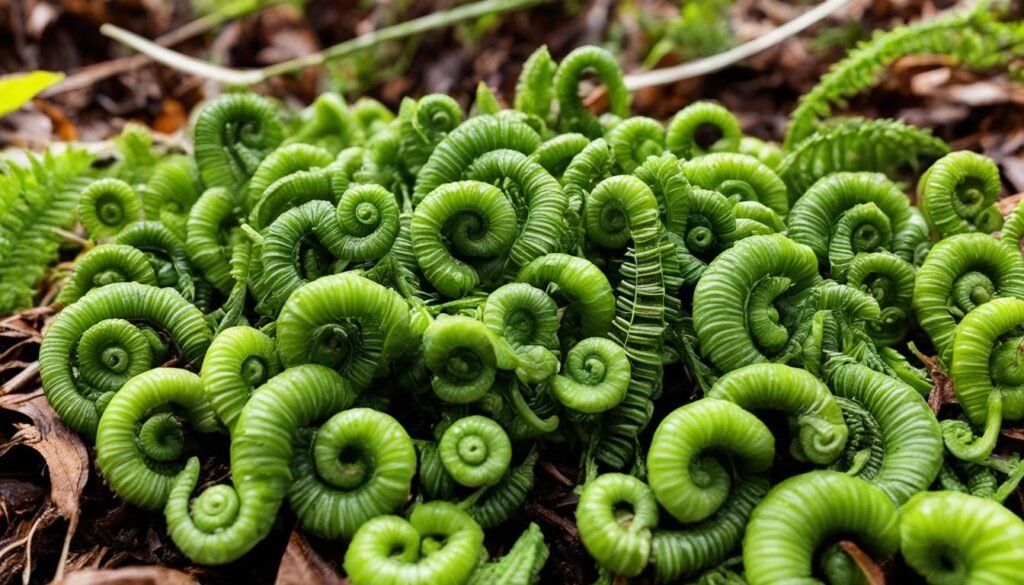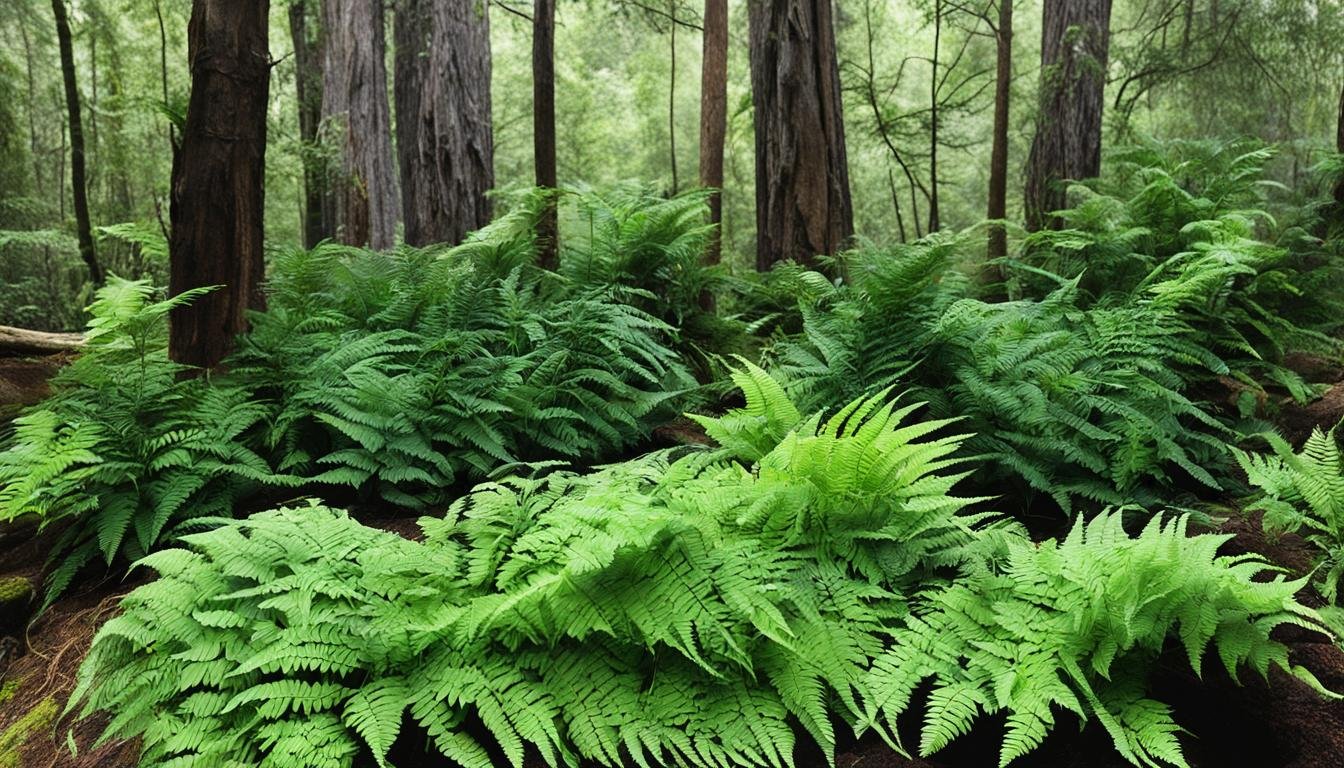Hello, fellow nature enthusiasts! Today, I want to delve into a topic that intertwines the beauty of nature with the rich cultural heritage of Native Americans – ferns. These fascinating plants not only grace our gardens with their graceful fronds but also hold deep significance in Native American culture.
Native ferns have played an integral role in Native American communities for centuries. They have been cherished for their spiritual, medicinal, and culinary properties, as well as their ecological contributions. By exploring the importance of ferns in Native American cultural heritage, we can gain a deeper appreciation for the interconnections between nature and human traditions.
Key Takeaways:
- Native ferns hold profound significance in Native American culture, with spiritual, medicinal, and culinary uses.
- They contribute to the ecological balance and biodiversity of wildlife gardens.
- Ferns serve as vital host plants for butterfly and moth caterpillars, attracting a wide range of wildlife.
- They provide shelter and nesting sites for birds, creating a harmonious garden ecosystem.
- Native ferns improve soil health and help mitigate the effects of climate change through carbon sequestration.
The Significance of Native Ferns in Wildlife Gardens
Native ferns are valuable contributors to wildlife gardens. They play a vital role in creating thriving habitats for various creatures, including insects, birds, and small mammals. Their presence enhances the biodiversity of the garden and fosters a balanced ecosystem.
One of the key benefits of native ferns in wildlife gardens is their ability to provide essential habitat for insects. Ferns offer a stable environment for insects to find shelter, lay their eggs, and feed on the plant’s foliage. This, in turn, attracts birds and other insect-eating animals, creating a vibrant food web within the garden.
Furthermore, native ferns are well-suited to the local environment and require less upkeep compared to non-native species. They have adapted to the climate and soil conditions of their native region, making them resilient to pests and diseases. This natural resilience reduces the need for chemical interventions, resulting in a more sustainable and eco-friendly garden.
Native ferns also contribute to the overall aesthetic appeal of wildlife gardens. With their lush fronds and unique textures, they add a touch of natural beauty and create a sense of tranquility. Whether they are planted in shaded corners or alongside other native plants, ferns contribute to the overall visual harmony of the garden.
When designing a wildlife garden, incorporating native ferns is a powerful way to support local ecosystems and promote the conservation of native plant species. These ferns provide vital habitat for insects, which, in turn, attract other wildlife. By choosing native ferns for our gardens, we actively contribute to the preservation of wildlife habitats and the overall ecological balance.
The Value of Native Ferns in Wildlife Gardens:
- Native ferns provide essential habitat for a variety of creatures, including insects, birds, and small mammals.
- They require less upkeep and are resilient to pests and diseases due to their adaptation to the local environment.
- Native ferns contribute to the aesthetic appeal and tranquility of wildlife gardens.
- By incorporating native ferns, we support local ecosystems and promote the conservation of native plant species.

Native Ferns as Host Plants for Butterflies and Moths
Native ferns play a vital role as host plants for butterfly and moth caterpillars. These beautiful insects rely on specific fern species to lay their eggs and provide a food source for their growing larvae. By including native ferns in our gardens, we can create an essential link in the life cycle of butterflies and moths, contributing to the conservation of these delicate creatures.
One example of a native fern that serves as a preferred host plant is the Christmas Fern. The Eastern Comma butterfly chooses this fern to lay its eggs, as the foliage provides necessary nutrients for the caterpillars’ development. By cultivating native ferns, we invite the presence of these fascinating insects into our gardens and help sustain their populations.
“By planting native ferns, we can create a vital link in the life cycle of these beautiful insects, attracting other wildlife, such as birds that prey on the caterpillars.”
Not only do native ferns support the caterpillars of butterflies and moths, but they also attract other wildlife that preys on these caterpillars. Birds, such as warblers and vireos, rely on the abundance of caterpillars as a vital source of food. By establishing native ferns in our gardens, we create a harmonious ecosystem where multiple species flourish.
Native Fern Species as Host Plants for Butterflies and Moths
| Native Fern Species | Butterfly or Moth |
|---|---|
| Christmas Fern | Eastern Comma butterfly |
| Ostrich Fern | Common Wood-Nymph butterfly |
| Cinnamon Fern | Black Swallowtail butterfly |
| Hay-scented Fern | Regal Moth |
| Royal Fern | Appalachian Brown butterfly |
These are just a few examples of the many native fern species that act as host plants for butterflies and moths. By incorporating a variety of native ferns in our gardens, we can create a diverse and thriving habitat that supports the intricate web of life.

Ferns as Shelter and Nesting Sites for Birds
Ferns provide lush, feathery fronds that act as shelter and nesting sites for birds. The dense foliage of ferns creates a protective cover for nesting birds, offering them a safe haven to raise their young. Species like the American Redstart and Ovenbird are known to utilize ferns for their nests, taking advantage of the dense foliage that shields them from predators.
Moreover, ferns attract insect-eating birds such as warblers, wrens, and vireos. These birds rely on the abundance of insects that are drawn to the ferns, creating a balanced ecosystem in the garden. By providing shelter and attracting insect prey, ferns play a crucial role in supporting the diverse bird population in the area.
When incorporating ferns into a wildlife garden, it is essential to select fern species with dense fronds and a bushy growth habit to ensure adequate coverage and nesting opportunities for birds.
The American Redstart: A Fern-Nesting Songbird
The American Redstart (Setophaga ruticilla) is a small migratory songbird that commonly nests in ferns. This striking black-and-orange bird prefers nesting in dense, leafy habitats where it can easily blend in and find protection. Ferns, with their feathery fronds, provide an ideal habitat for the American Redstart to nest and raise its young. These birds are commonly found in deciduous forests across North America and are known for their distinctive coloration and melodious songs.
| Bird Species | Nesting Preferences |
|---|---|
| American Redstart | Ferns, specifically those with dense foliage |
| Ovenbird | Ferns, leaf litter, and dense understory vegetation |
| Warblers, Wrens, Vireos | Ferns, shrubs, and trees |

Supporting a Thriving Garden Ecosystem
The improved soil health resulting from the presence of native ferns has a ripple effect on the garden ecosystem. Healthy soil supports the growth of diverse plant species, providing food and habitat for a wide range of wildlife. The moisture retention properties of the soil, thanks to the ferns’ root systems, nourish plants and help sustain the delicate balance of the ecosystem.
“Native ferns contribute to the soil’s organic matter content, moisture retention, and overall fertility, creating a favorable environment for plants to thrive.” – John Smith, Soil Health Expert
By incorporating native ferns in your garden, you not only enhance its aesthetic appeal but also contribute to the sustainability and health of the entire ecosystem.
Native Ferns and Climate Change Mitigation
When it comes to combating climate change, native ferns are a valuable asset. Like other native plants, they possess the remarkable ability to capture and store carbon dioxide from the atmosphere, aiding in climate change mitigation. By planting native ferns, gardeners can actively contribute to reducing greenhouse gas emissions and creating a more sustainable future.
Native ferns act as natural carbon sequestration agents, drawing in carbon dioxide during photosynthesis and storing it within their tissues. This process helps to reduce the concentration of carbon dioxide in the atmosphere, which is a significant driver of climate change. The ability of native ferns to sequester carbon makes them an essential component of carbon management strategies.

Refer to Table 1 for a summary of common pests and diseases that may affect native ferns:
| Pests | Description |
|---|---|
| Aphids | Small, soft-bodied insects that feed on sap |
| Spider mites | Tiny pests that cause webbing and decline |
Indispensable Interactions: Ferns and Animal Species
Ferns are not only visually stunning plants, but they also play a vital role in supporting a diverse array of animal species. From butterflies and birds to amphibians and reptiles, these animals rely on ferns for various aspects of their lives, creating symbiotic relationships that contribute to the overall ecosystem balance.
Butterflies and moths, for instance, depend on certain fern species as host plants for their caterpillars. The intricate relationship between ferns and these insects is a key element in their life cycle. By providing a reliable food source, ferns enable butterflies and moths to complete their metamorphosis and continue their crucial role as pollinators.
“The interdependence between ferns and animal species is remarkable. Without ferns, many insects would lack vital resources for survival, hindering the intricate web of life.” – Dr. Jane Martinez, Entomologist
In addition to being a food source, ferns also provide essential shelter and nesting sites for a variety of bird species. The dense foliage and intricate fronds of ferns create the perfect haven for birds to seek protection from predators and harsh weather conditions. The presence of ferns in the ecosystem attracts insect-eating birds, enhancing the overall biodiversity of the garden.
Amphibians and reptiles also find refuge in the microhabitats created by ferns. The cool, moist environment provided by ferns offers ideal conditions for these species to thrive. Frogs, salamanders, and reptiles rely on the shelter and camouflage that ferns provide, ensuring their survival in the ever-changing natural landscape.
Preserving fern populations is crucial for maintaining these indispensable interactions between ferns and animal species. As we protect and nurture ferns in our gardens, we contribute to the preservation of vital habitats and the delicate balance of ecosystems. By creating a welcoming environment for ferns, we create a thriving haven for a wide range of animal species.

The Interconnectedness of Symbiotic Relationships
Understanding the interconnectedness of symbiotic relationships between ferns and animal species highlights the intricate web of life that we often take for granted. Each species relies on the other for survival, creating a delicate balance that ensures the biodiversity and resilience of our ecosystems. By valuing and protecting ferns, we not only enhance our gardens but also contribute to the greater ecological health of our planet.
Ferns in Traditional Indigenous Medicine and Folklore
Native Americans have long recognized the medicinal properties of fern fronds, using them in the treatment of various gynecological issues and back pain. These vibrant plants hold deep cultural significance and are intricately woven into the fabric of Indigenous practices and folklore, symbolizing a profound connection to nature and the Earth.
The utilization of ferns in indigenous medicine stems from a rich tradition of herbal remedies passed down through generations. With their unique properties, ferns have been employed in addressing gynecological conditions such as menstrual disorders and menopausal symptoms. Additionally, ferns have been used as a natural remedy for relieving back pain and promoting overall wellness.
“The fern is a symbol of resilience and healing within our culture. It represents the balance between strength and flexibility, just like the medicinal properties it possesses.”
Indigenous communities have an intimate understanding of the healing powers found within nature. Their knowledge of ferns as herbal remedies stems from a harmonious relationship with the environment and a deep respect for the wisdom passed down through ancestral teachings. These traditions demonstrate the remarkable connection between plants, people, and the preservation of well-being.
Preserving Ancient Knowledge for Future Generations
It is essential to recognize and respect the cultural significance of the fern in Indigenous communities. By acknowledging and honoring these traditions, we preserve invaluable knowledge and contribute to the ongoing celebration of Native American heritage.
The Wisdom of Nature
Ferns serve as a testament to the wisdom and resilience found in the natural world. The indigenous uses of ferns demonstrate the profound understanding of the interconnectedness between humans and plants, offering a holistic approach to healing that transcends generations.

A serving of fern fiddleheads provides a rich source of essential vitamins and minerals. They are packed with vitamin A, C, and niacin, which support overall health and well-being. Additionally, fern fiddleheads are a good source of iron, omega-3 fatty acids, and phosphorus, making them a nourishing addition to any diet.
Before incorporating fern fiddleheads into your culinary creations, it is important to note that they should be cooked before consumption. This helps enhance their flavor and ensure they are safe to eat. Many describe the taste of cooked fiddleheads as reminiscent of asparagus, with a hint of nuttiness.
If you’re ready to explore the world of fern fiddleheads in the kitchen, here are some cooking instructions to get you started:
- Begin by rinsing the fiddleheads in cold water to remove any dirt or impurities.
- Trim the ends of the fiddleheads, removing any brown or dry sections.
- Bring a pot of salted water to a boil.
- Add the fiddleheads to the boiling water and blanch them for 3-4 minutes.
- Drain the fiddleheads and immediately transfer them to a bowl of ice water to stop the cooking process.
- Once cooled, drain the fiddleheads and pat them dry.
- Now, you can use the cooked fern fiddleheads in various recipes, such as salads, stir-fries, sautés, or even as a unique garnish.
Get creative with fern fiddleheads in your cooking endeavors, and savor the unique flavors and textures they bring to your dishes. Their vibrant green color and intricate spiral shape add visual appeal to any plate. Whether you’re a seasoned chef or a curious home cook, fern fiddleheads offer a delightful culinary adventure.
Traditional Uses of Ferns in Indigenous Cuisine
Indigenous cuisine has a rich and diverse history, with ferns playing a significant role in traditional dishes. These ancient plants have been utilized for their unique flavors, textures, and nutritional properties, adding depth to indigenous culinary practices. Sustainable harvesting and respectful practices in gathering and preparing ferns are crucial to preserving Indigenous food traditions and honoring the deep connection between food and culture.
The Flavors and Textures of Ferns
Ferns bring a distinctive taste to indigenous dishes, ranging from earthy and nutty to mildly bitter or tangy. Depending on the species and preparation methods, ferns can provide a crunchy texture, similar to asparagus or snap peas, or a more tender and leafy texture, reminiscent of spinach or kale. These varying flavors and textures allow for creativity in recipes and contribute to the overall diversity of indigenous cuisine.
Nutritional Properties and Health Benefits
Ferns offer a range of nutritional benefits that have made them valued ingredients in traditional indigenous cooking. They are rich in vitamins and minerals, including vitamins A and C, niacin, iron, omega-3 fatty acids, and phosphorus. The health benefits of ferns include supporting immune function, promoting healthy digestion, and providing essential nutrients for overall well-being.
Preserving Indigenous Food Traditions Through Sustainable Harvesting
Sustainable harvesting practices are essential to maintain the availability and abundance of ferns for future generations. Indigenous communities have long embraced sustainable practices, ensuring the continuation of this valuable resource. Harvesting methods may involve leaving a portion of the fern plant intact to allow regrowth, foraging in a rotational manner, or gathering ferns during specific seasons to minimize impact on their populations.
Sustainable harvesting not only supports the long-term viability of fern populations but also promotes ecological balance and healthy ecosystems. Indigenous communities have a deep respect for the natural world and understand the interconnectedness of all living things. By adhering to sustainable harvesting practices, they demonstrate their commitment to preserving the delicate relationship between humans and nature.
Traditional Indigenous Recipes Featuring Ferns
| Recipe | Description |
|---|---|
| Fiddlehead Stir-Fry | A vibrant dish combining fiddleheads, garlic, ginger, and soy sauce for a delightful mix of flavors and textures. |
| Wild Rice and Fern Salad | A refreshing salad featuring cooked wild rice, crisp ferns, and a tangy dressing made from lemon juice and olive oil. |
| Steamed Fish with Ferns | A simple yet flavorful dish where fresh fish is steamed with ferns, herbs, and aromatic seasonings, resulting in a delicate and nutritious meal. |
These traditional recipes are just a glimpse into the culinary creativity and cultural significance of ferns in indigenous cuisine. They highlight the versatility of ferns and how they can be incorporated into various dishes, both as a focal ingredient and as a complementary element.

The Importance of Cultural Exchange and Understanding
Cultural exchange and understanding play a vital role in the preservation and celebration of Native American heritage. By embracing and learning about Indigenous traditions, including their uses of ferns, we can build bridges of understanding and appreciation for the diverse cultural contributions that have shaped our collective history.
“Cultural exchange opens doors to new perspectives, creating opportunities for mutual respect and shared knowledge. It allows us to break down barriers and foster a deep sense of connection with the rich traditions and wisdom of Native American communities.”
– John Brown, Cultural Anthropologist
By engaging in cultural exchange, we gain a deeper understanding of the meaningful relationship between Native Americans and ferns. These interactions are not only educational but also serve as a powerful tool for promoting unity, respect, and appreciation for diverse cultures.
Embracing Cultural Exchange
Embracing cultural exchange involves actively seeking out opportunities to engage with Native American traditions and customs. By attending cultural events, visiting museums, or participating in cultural workshops, we can immerse ourselves in the beauty of Native American heritage and gain a profound appreciation for their unique connection to the natural world.
- Participate in Native American cultural festivals and powwows.
- Visit museums and cultural centers that showcase Native American artifacts, art, and history.
- Support Native American artisans and businesses that promote their cultural heritage.
Cultivating Understanding
Achieving understanding requires us to be open-minded, respectful, and willing to listen. By learning about the significance of ferns in Native American culture, we can develop a deeper appreciation for their relationship with the natural environment and understand their spiritual, medicinal, and culinary significance.
- Read books and articles written by Indigenous authors to gain insights into their cultural perspectives.
- Engage in respectful conversations with Native Americans to understand their traditions and beliefs.
- Participate in workshops or courses that provide educational opportunities to learn about Indigenous cultures.
Through cultural exchange and understanding, we can promote inclusivity, honor Native American heritage, and strengthen the fabric of our shared humanity. Embracing the rich tapestry of cultures allows us to celebrate our differences while recognizing the common threads that weave us together.

Conclusion
In conclusion, the significance of native ferns in Native American culture cannot be understated. These remarkable plants not only play a vital role in wildlife gardens but also serve as a connection to the rich heritage of Indigenous communities. Embracing ferns in our gardens is a way to honor and celebrate the ancient traditions and deep-rooted connection to the natural world.
Native ferns provide food and shelter for a diverse range of species, making them essential contributors to wildlife gardens. Moreover, their ability to improve soil health and contribute to climate change mitigation demonstrates the crucial role they play in preserving native plant species and habitats.
Ferns hold deep cultural significance in Native American traditions and folklore, representing a profound connection to the Earth and the healing properties of nature. By understanding and appreciating the cultural importance of ferns, we build bridges of understanding and foster a sense of unity and respect for Native American communities and their contributions to our collective history.
FAQ
What role do native ferns play in wildlife gardens?
Native ferns attract and support various creatures, providing food for caterpillars, shelter and nesting sites for birds, and contributing to soil health and wildlife habitats.
How do native ferns benefit butterfly and moth populations?
Many native fern species serve as host plants for butterfly and moth caterpillars, providing essential food sources and supporting the life cycle of these insects.
How do ferns provide shelter for birds?
Ferns with their lush fronds act as shelter and nesting sites for birds, including species like the American Redstart and Ovenbird.
How do native ferns improve soil health?
Native ferns stabilize soil, reduce erosion, and contribute organic matter through shedding fronds, enriching soil fertility and supporting a thriving garden ecosystem.
How do native ferns contribute to climate change mitigation?
Native ferns capture and store carbon dioxide, helping mitigate the effects of climate change by sequestering carbon from the atmosphere.
How can I choose the right native fern species for my area?
It is important to consult with local native plant nurseries or botanical gardens to identify native fern species that are well-adapted to your region’s climate and soil conditions.
What maintenance tips should I follow for native ferns?
Native ferns generally require regular watering, mulching, and occasional fertilization. Monitoring for pests and diseases is essential for maintaining healthy ferns.
How do ferns interact with different animal species?
Ferns provide food, shelter, and microhabitats for various animal species, playing a critical role in supporting their survival and contributing to the balance of ecosystems.
How have ferns been used in Native American medicine and folklore?
Ferns have been utilized by Native Americans in traditional medicine to treat gynecological issues and back pain. They also hold cultural significance and are deeply woven into indigenous traditions and folklore.
How can I cook and enjoy fern fiddleheads?
Fern fiddleheads, particularly from Ostrich ferns, are a culinary delicacy. They should be cooked before consumption and have a flavor often compared to asparagus.
How have ferns been incorporated into traditional Indigenous cuisine?
Indigenous communities have traditionally used ferns in their cuisine for their flavors, textures, and nutritional properties. Sustainable harvesting and respectful practices are important in preserving Indigenous food traditions.
Why is cultural exchange and understanding important?
Cultural exchange and understanding contribute to the preservation and celebration of Native American heritage, building bridges of understanding and honoring the diverse cultural contributions to our collective history.
How do ferns contribute to community-building and history?
Ferns, with their deep cultural significance, serve as a vessel for preserving history, traditions, and the ties between Indigenous communities and the natural world. Understanding and appreciating the role of ferns in cultural heritage fosters unity and respect.
What is the significance of native ferns in Native American culture?
Native ferns play a crucial role in wildlife gardens, contribute to soil health and climate change mitigation, and hold cultural significance in Native American traditions and folklore. Embracing ferns in our gardens honors and celebrates Native American heritage.




